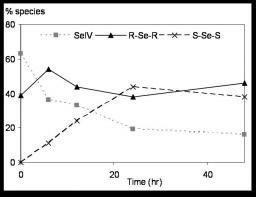Resistance, accumulation and transformation of selenium by the cyanobacterium Synechocystis sp. PCC 6803 after exposure to inorganic SeVI or SeIV
B. Gouget, L. Avoscan, R. Collins, M. Carrière



FIG. 1: The evolution of selenium species in Synechocystis exposed to 40 µM selenate as determined by XANES linear combination fitting. After exposure to SeVI, spectra could be suitably fitted using the 3 components: SeIV, R-Se-R and R-Se-Se-R.
Coll. G. Sarret*
*Environmental Geochemistry Group, LGIT, University of Grenoble and CNRS, BP 53, 38041 Grenoble, Cedex 9, France.
Our purpose was to investigate the ability of Synechocystis sp. PCC 6803, a photosynthetic prokaryote isolated from fresh water, to resist, incorporate and reduce the oxidized forms of selenium including selenite and selenate, the major selenium species present in aquatic systems. Selenium speciation and the chemical intermediates during selenium transformation were determined by X-ray absorption near edge structure (XANES) spectroscopy. The possible internalisation pathways involving selenium and the metabolic fate of selenate and selenite were examined. Selenate metabolism seemed to proceed via the sulfate reduction pathway resulting in the formation of the R-Se-H, R-Se-R and R-Se-Se-R species. The transformation of selenate to toxic amino acids may explain the high sensitivity of Synechocystis to selenate. Several mechanisms of selenium reduction seem to compete during selenite assimilation. A specific mechanism may transform internalised selenite into selenide and, subsequently induce the biosynthesis of selenoproteins. A non-specific mechanism may interfere with thiols, such as glutathione in the cell cytoplasm, or with proteins in the periplasm of the bacteria, notably thioredoxins. Several hypotheses concerning the complex transformation of selenium in Synechocystis could therefore be proposed.
#423 - Last update : 03/25 2005
•  Physics and chemistry for life sciences and the environment › Human and Environmental Toxicology
Physics and chemistry for life sciences and the environment › Human and Environmental Toxicology
• Laboratoire Pierre Süe UMR 9956 CEA-CNRS • Pierre Süe Laboratory UMR 9956 CEA-CNRS









